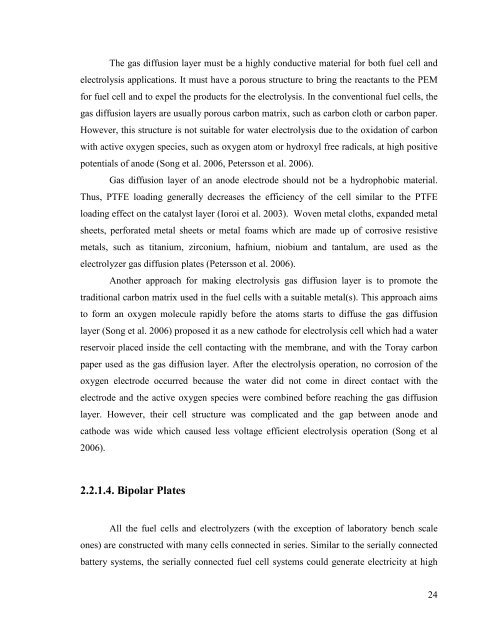hydrogen production from water using solar cells powered nafion ...
hydrogen production from water using solar cells powered nafion ...
hydrogen production from water using solar cells powered nafion ...
You also want an ePaper? Increase the reach of your titles
YUMPU automatically turns print PDFs into web optimized ePapers that Google loves.
The gas diffusion layer must be a highly conductive material for both fuel cell and<br />
electrolysis applications. It must have a porous structure to bring the reactants to the PEM<br />
for fuel cell and to expel the products for the electrolysis. In the conventional fuel <strong>cells</strong>, the<br />
gas diffusion layers are usually porous carbon matrix, such as carbon cloth or carbon paper.<br />
However, this structure is not suitable for <strong>water</strong> electrolysis due to the oxidation of carbon<br />
with active oxygen species, such as oxygen atom or hydroxyl free radicals, at high positive<br />
potentials of anode (Song et al. 2006, Petersson et al. 2006).<br />
Gas diffusion layer of an anode electrode should not be a hydrophobic material.<br />
Thus, PTFE loading generally decreases the efficiency of the cell similar to the PTFE<br />
loading effect on the catalyst layer (Ioroi et al. 2003). Woven metal cloths, expanded metal<br />
sheets, perforated metal sheets or metal foams which are made up of corrosive resistive<br />
metals, such as titanium, zirconium, hafnium, niobium and tantalum, are used as the<br />
electrolyzer gas diffusion plates (Petersson et al. 2006).<br />
Another approach for making electrolysis gas diffusion layer is to promote the<br />
traditional carbon matrix used in the fuel <strong>cells</strong> with a suitable metal(s). This approach aims<br />
to form an oxygen molecule rapidly before the atoms starts to diffuse the gas diffusion<br />
layer (Song et al. 2006) proposed it as a new cathode for electrolysis cell which had a <strong>water</strong><br />
reservoir placed inside the cell contacting with the membrane, and with the Toray carbon<br />
paper used as the gas diffusion layer. After the electrolysis operation, no corrosion of the<br />
oxygen electrode occurred because the <strong>water</strong> did not come in direct contact with the<br />
electrode and the active oxygen species were combined before reaching the gas diffusion<br />
layer. However, their cell structure was complicated and the gap between anode and<br />
cathode was wide which caused less voltage efficient electrolysis operation (Song et al<br />
2006).<br />
2.2.1.4. Bipolar Plates<br />
All the fuel <strong>cells</strong> and electrolyzers (with the exception of laboratory bench scale<br />
ones) are constructed with many <strong>cells</strong> connected in series. Similar to the serially connected<br />
battery systems, the serially connected fuel cell systems could generate electricity at high<br />
24

















